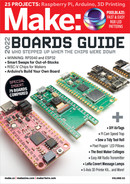
How will you know that IC2 is actually doing
anything?
If you have an AM radio, try tuning it to the
middle of its range, and hold your radio close
to the yellow loop antenna on the breadboard.
If you adjust the radio carefully, and turn it from
side to side, you should be able to hear the audio
frequency.
Congratulations! You just demonstrated a radio
transmitter — and sent power through thin air.
LOCAL RECEPTION
Wouldn’t it be even more interesting to build a
receiver of your own? This is easily done.
Two main types of transmission are used
by radio stations today: frequency modulated
(abbreviated as FM) and amplitude modulated
(AM). The earliest radio transmissions were AM,
meaning that the loudness of a sound coming out
of the radio was proportional with the amplitude,
or voltage, of the signal.
In our book Make: Electronics, we included a
radio in Experiment 28, titled “One Radio, No
Solder, No Power.” You could use this radio to
pick up your audio tone from your 555 transmitter
circuit, but building it is a bit of a chore, as you
need to wind many turns of wire around a large
object such as an empty multivitamin bottle. We
now suggest a better option, if you don't mind
acquiring a ferrite rod, which you should be able
to find for a very modest cost.
Ferrite conveniently intensifies the effect of a
coil. You can use everyday 22-gauge hookup wire
to wind 63 turns around the rod. To make them
fit, you may need to wind the turns in two layers,
one on top of the other, as in Figure
H
. Make
sure that all the turns go in the same direction,
and tape them in place. We show a file card
curled around the rod, inside the coil, so that you
can slide the coil up and down the rod to adjust
reception. For your basic test, though, this isn't
necessary.
Figure
I
shows the schematic for your ultra-
simple radio, while Figure
J
suggests how you
can twist the wires together so you don’t need a
breadboard. The green wires go to the coil, while
the black wires go to the earphone. The diode is
the blue component with a black end.
Figure
K
on the following page shows how
I
G
The schematic for an ultra-simple AM radio
receiver.
Output from the second timer. The oscilloscope
has downsampled the high frequencies to make
the oscillations individually visible.
10
8
6
4
2
0
-2
-4
-6
-8
-10
0 1 2 3 4 5 6 7 8 9 10
milliseconds
volts
D1
L1
C1
R1
LS1
Coil, 63 turns on ferrite rod
Tuning capacitor, 200pF
BAT48 Schottky diode or similar
10K resistor
High-impedance earphone
L1
C1
D1
R1
LS1
Components
Charles Platt
H
A coil of 63 turns of 22-gauge wire, in two
layers on a ferrite rod.
J
Connecting the coil (green wires), earphone (black
wires), resistor, and diode.
67
make.co
M83_062-69_BookEx-Radio_F1.indd 67M83_062-69_BookEx-Radio_F1.indd 67 10/10/22 3:32 PM10/10/22 3:32 PM
..................Content has been hidden....................
You can't read the all page of ebook, please click here login for view all page.
